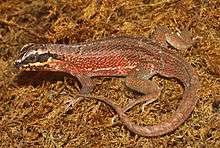Iguanomorpha
Iguania is an infraorder of squamate reptiles that includes iguanas, chameleons, agamids, and New World lizards like anoles and phrynosomatids. Consisting of nearly 13,000 named species. T Using morphological features as a guide to evolutionary relationships, the Iguania are believed to form the sister group to the remainder of the Squamata. However, molecular information has placed Iguania well within the Squamata as sister taxa to the Anguimorpha and closely related to snakes.[1]. The order has been under debate and revisions after being classified by Charles Lewis Camp in 1923 due to difficulties finding adequate synapomorphic morphological characteristics. [2] The majority of Iguanias are arboreal but there are several terrestrial groups. They usually have primitive fleshy, non-prehensile tongues, although the tongue is highly modified in chameleons. The group has a fossil record that extends back to the Early Jurassic (the oldest known member is Bharatagama, which lived about 190 million years ago in what is now India).[3]. Today they are scattered occurring in Madagascar, the Fiji and Friendly Islands and Western Hemisphere [4]
| Iguanomorpha | |
|---|---|
 | |
| Leiocephalus personatus, a species of iguanian | |
| Scientific classification | |
| Kingdom: | Animalia |
| Phylum: | Chordata |
| Class: | Reptilia |
| Order: | Squamata |
| Clade: | Toxicofera |
| Clade: | Iguanomorpha |
| Suborder: | Iguania |
| Families | |
Classification
The Iguania currently include these extant families:[5][6]
- Clade Acrodonta
- Family Agamidae – agamid lizards, Old World arboreal lizards
- Family Chamaeleonidae – chameleons
- Clade Pleurodonta – American arboreal lizards, chuckwallas, iguanas
- Family Leiocephalidae
- Genus Leiocephalus: curly-tailed lizards
- Family Corytophanidae – helmet lizards
- Family Crotaphytidae – collared lizards, leopard lizards
- Family Hoplocercidae – dwarf and spinytail iguanas
- Family Iguanidae – marine, Fijian, Galapagos land, spinytail, rock, desert, green, and chuckwalla iguanas
- Family Tropiduridae – tropidurine lizards
- subclade of Tropiduridae Tropidurini – neotropical ground lizards
- Family Dactyloidae – anoles
- Family Polychrotidae
- subclade of Polychrotidae Polychrus
- Family Phrynosomatidae – North American spiny lizards
- Family Liolaemidae – South American swifts
- Family Opluridae – Malagasy iguanas
- Family Leiosauridae – leiosaurs
- subclade of Leiosaurini Leiosaurae
- subclade of Leiosaurini Anisolepae
- Family Leiocephalidae
Phylogeny
Below is a cladogram from the phylogenetic analysis of Daza et al. (2012) (a morphological analysis), showing the interrelationships of extinct and living iguanians:[7]
| Iguanomorpha |
| |||||||||||||||||||||||||||||||||||||||||||||||||||||||||||||||||||||||||||||||||||||||||||||||||||||||||||||||||||||||||||||||||||||||||||||||||||||||||||||||||||||||||||||||||||||||||||||||||||||||||||||||||||||||||||||||||||||||||||||||||||||||||||||||||||||||||||||||||||||||||||||||||||||||||||||||||||||||||||||||||||||||||||||||||||
Conservation Status
As of 2020 The IUCN Red List of endangered species lists 63.3% of the species as Least concern, 6.7% Near Threatened, 8.2 vulnerable, 9.1% endangered, 3.1% critically endangered, 0.3 extinct and 9.2% data deficient. The major threats include agriculture , residential and commercial development {https://www.iucnredlist.org/}.
References
- Vidal, N.; Hedges, S. B. (2005). "The phylogeny of squamate reptiles (lizards, snakes, and amphisbaenians) inferred from nine nuclear protein-coding genes" (PDF). Comptes Rendus Biologies. 328 (10–11): 1000–1008. doi:10.1016/j.crvi.2005.10.001. PMID 16286089. Archived from the original (PDF) on 2011-07-26.
- Daza, J., Abdala, V., Arias, J., García-López, D., & Ortiz, P. (2012). Cladistic Analysis of Iguania and a Fossil Lizard from the Late Pliocene of Northwestern Argentina. Journal of Herpetology, 46(1), 104-119. Retrieved May 12, 2020, from www.jstor.org/stable/41515023
- Evans, Susan E.; Prasad, G. V. R.; Manhas, B. K. (2002). "Fossil lizards from the Jurassic Kota Formation of India". Journal of Vertebrate Paleontology. 22 (2): 299. doi:10.1671/0272-4634(2002)022[0299:FLFTJK]2.0.CO;2.
- Moody, S. (1985). Charles L. Camp and His 1923 Classification of Lizards: An Early Cladist? Systematic Zoology, 34(2), 216-222. doi:10.2307/2413329
- Wiens, J.J., C. R. Hutter, D. G. Mulcahy, B. P. Noonan, T. M. Townsend, J. W. Sites Jr., T. W. Reeder. (2012) Resolving the phylogeny of lizards and snakes (Squamata) with extensive sampling of genes and species. Archived 2018-08-05 at the Wayback Machine Biology Letters
- Schulte II, J. A., J. P. Valladares, and A. Larson. (2003) [Phylogenetic relationships within Iguanidae inferred using molecular and morphological data and a phylogenetic taxonomy of iguanian lizards.] Herpetologica 59: 399-419
- Daza, J. D.; Abdala, V.; Arias, J. S.; García-López, D.; Ortiz, P. (2012). "Cladistic Analysis of Iguania and a Fossil Lizard from the Late Pliocene of Northwestern Argentina". Journal of Herpetology. 46: 104–119. doi:10.1670/10-112.
| Wikimedia Commons has media related to Iguania. |